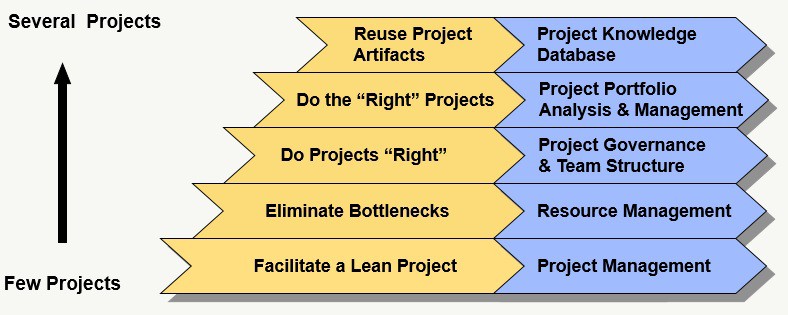A Scalable Model for Lean Product Development
In my previous article we established the lean product development goal statement as:
Develop products that maximize customer value and minimize product cost, in the least amount of time, and at the least amount of product development cost.
We then derived high-level objectives as follows:
- Better understand the customer (maximize customer value)
- Do the right projects (product, project and portfolio value analysis)
- Do projects right (minimize redesigns, waste and rework)
- Level load the organization (minimize bottlenecks and resource constraints)
- Create and re-use artifacts (standardize and sustain best practices)
These might be considered “enterprise” level objectives…some or all of the objectives might be part of a product development organizational strategy depending on type and/or quantity of development projects.
Let us start by listing lean objectives based the quantity of product development projects:

More projects generally require more governance and management, including managing resources across projects.
Several elements of lean are apparent:
- reduce work-effort on the wrong projects
- eliminate rogue projects
- cancel projects that no longer make business sense
- reduce bottlenecks by effectively managing resources
- enforce or encourage process discipline
Note an element of ‘slowing-down-to-go-faster’ here….investing work-effort into project governance to achieve significant savings, and enable more valuable projects to be completed faster.
A tailored approach would also consider the type of product development project. A project goal might be to demonstrate a minimum viable product (perhaps a start-up company) or pursue complete product commercialization (manufacturing company).
The graphic below provides some suggested lean product development objectives and initiatives accordingly.

A development process, with the ultimate goal of product commercialization, might place more emphasis on reducing design risk, design optimization & manufacturability. Elements of lean enable the technical process by which customer value is maximized and product cost is minimized.
This brings us to our final category of enabling lean: making good business decisions. Investing in a product or project is ultimately a business decision that can be improved with financial estimating and analysis. Here again we consider the type of product development project, and emphasize customer value, product cost and project cost.

A business decision priority for demonstrating a minimum viable product might include (as a minimum) ensuring corresponding value to the customer. Meanwhile, a more comprehensive financial analysis is more appropriate for many (or larger) projects going through complete commercialization.
Lean product development approaches are scalable based on several factors; a company may perform some project retrospectives, perform an internal survey or assessment, or begin with some awareness of tools and methodologies. ….do you have too many projects? projects that weren’t ultimately successful? resource constraints? high risk of design rework? sub-optimized designs? inadequate product margins? difficult-to-manufacture products?
The most effective and beneficial elements of lean enterprise product development could be down-selected. Even without much project history, risk can be significantly reduced by starting with the basic elements of lean product development. There are likely many opportunities to streamline your product development process. Contact Rob Allen in the form below for additional information or an initial consultation.
Recent Posts
Categories
- Agile (1)
- Change Management (2)
- Design for Six Sigma (3)
- Ideation (1)
- Lean Manufacturing (1)
- Lean Product Development (5)
- Maximizing Customer Value (3)
- Product Lifecycle Process (5)
- Project Governance (1)
- Project Management (9)
- Requirements Management (8)
- Roles and Responsibilities (3)
- Six Sigma (1)
- Supply Chain (1)
- Systems Integration (1)
- Uncategorized (12)
- Value Stream Management (5)
- Verification and Validation (6)
